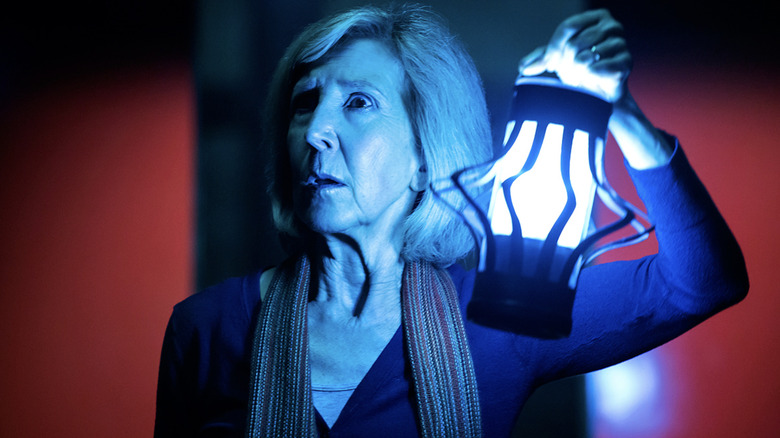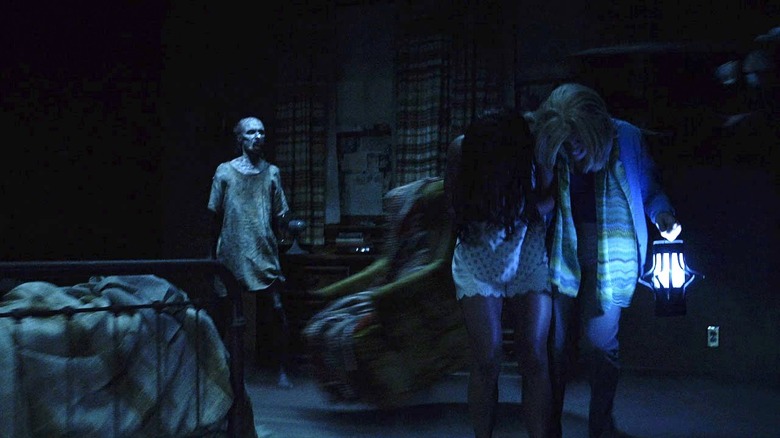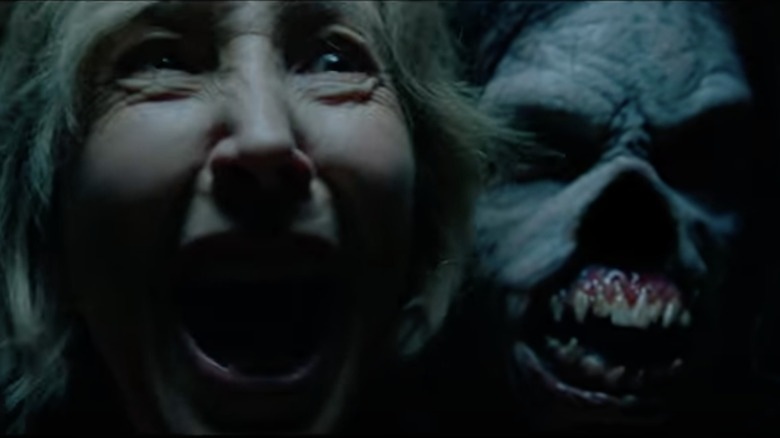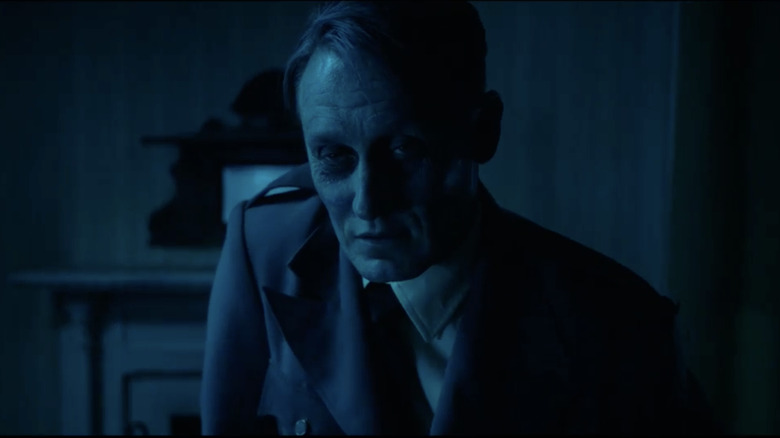How Insidious Deleted Scenes Take Us Further Into The Further
James Wan and Leigh Whannell burst onto the horror scene with their genre-changing 2004 horror film, "Saw," which exploded in popularity and spiraled out into a massive franchise. A few years later, the duo joined forces with the horror mavens over at Blumhouse to deliver "Insidious," a terrifying film about a family terrorized by numerous malicious spirits. The film was a ginormous success at the box office, bringing in over $100 million against a budget of roughly $1.5 million. With numbers like that, there was no way Blumhouse was going to miss out on the franchise potential.
The "Insidious" films all center around a dimension known as the Further, a sort of limbo plane between Heaven, Earth, and Hell that houses the souls of the damned. This means that the inhabitants of the Further are vast and varied, a collection of nightmarish figures looking for a way out by any means necessary.
2023 marks the fifth installment of the series, with "Insidious: The Red Door" coming over a decade after the first film's debut. The film will reunite audiences with the Lambert family of the first two "Insidious" films, years after the tragic passing of Elise Rainier (Lin Shaye) but once again focusing on patriarch Josh (Patrick Wilson) and son Dalton (Ty Simpkins) who have both been used as vessels by dangerous forces from within the Further looking to rejoin the land of the living. There's some truly incredible and rich horror storytelling to explore within the "Insidious" films, but there's also plenty of interesting information to examine when looking at moments audiences didn't get to see in theaters. Both "Insidious: Chapter 3" and "Insidious: The Last Key," the prequel films of the franchise, have deleted scenes that help take us further into the Further.
Deleted scenes in Insidious Chapter 3
"Insidious Chapter 3" was Leigh Whannell's directorial debut and is the first film not to prominently feature the Lambert family. In it, a teenage girl named Quinn Brenner (Stefanie Scott) is mourning the loss of her mother when she starts feeling a supernatural presence. Convinced it's her mother reaching out, Quinn enlists the help of Elise Rainier to bring her closer to her mother's spirit. Unfortunately, the entity is actually a malevolent presence from the Further known as the "Man Who Can't Breathe." Elise brings along parapsychologists Tucker (Angus Sampson) and Specs (Leigh Whannell) as they try to keep Quinn safe.
The Blu-ray release of the film included three deleted scenes, and while none include any massive scares or visions into the Further, they do provide a deeper understanding of the characters' motivations and emphasize the ways that trauma made Quinn a vulnerable conduit for those within the Further looking for a way out. The first scene sees Quinn and her best friend Maggie (Hayley Kiyoko) going through a memory box of photos and keepsakes: a loving nod to the close relationship Quinn had with her mother, Lily. It's understandable that the scene was cut for time, but considering the climax of the film sees Lily assisting Quinn in the Further, it would have made the emotional moment hit even harder.
The second deleted scene is a discussion between Quinn's father Sean (Dermot Mulroney) and a doctor after Quinn is hurt in an accident. Sean delivers an impassioned speech about protecting his daughter and not trusting the words of a doctor given his past trauma related to his wife's passing. The third scene is another Sean moment, but it's him talking with Tucker and Specs at the house. It's again, an understandable scene to cut, but Tucker and Specs are so entertaining it's doubtful anyone would have complained about giving them more screen time.
Deleted scenes in Insidious: The Last Key
Blumhouse went above and beyond with the physical media release of "Insidious: The Last Key," including eight deleted scenes and an alternate ending. Unlike "Insidious: Chapter 3," many scenes left on the cutting room floor for "The Last Key" feature terrifying imagery and some pretty decent frights. One quick scene shows Elise approaching a door and upon touching the doorknob, is thrown out of the room and into the Further. The film centers on Elise investigating a haunting in her childhood home, so the moment is particularly frightening as the Further looks like a twisted version of where she grew up.
Many of the deleted scenes feature Elise exploring the Further version of her home, with director Adam Robitel's fantastically paced jump scares well on display. One particular moment is an evolution of the now iconic jump scare of the "Lipstick-Face Demon" appearing behind Patrick Wilson's Josh Lambert in the first "Insidious" film, but this time with Lin Shaye's Elise in a dark room in the Further. As she investigates, she comes face to face with a door and is sure something is going to be on the other side. Instead, a horrifying figure sneaks up behind her and pops out over her shoulder. It's an effective throughline between "Insidious" and "Insidious: The Last Key," and proof positive that a good jump scare will never go out of style.
The TV scene in Insidious: The Last Key
The most important deleted scene of the bunch is one that features Elise entering a room with a television set playing gruesome images of a woman being hanged and struggling to free herself. When the footage stops, the reflection on the TV shows Elise and a ghostly figure sitting in a chair. But it's not just any ghostly figure: it's Gerald Rainier (Josh Stewart), Elise's abusive father who is revealed to have captured and tortured young women while he was alive. Now, Elise is in the Further with the malicious spirit of her father, who belittles her and threatens to take her "further than [she's] ever been in the dark."
This scene is fantastic because it shows that even a strong-willed, fearless person like Elise is not immune to feeling fear. Elise has never been more vulnerable or openly scared in any of the films than the way she is coming face to face with her father. He is the source of not just the personal trauma in her life, but also her connection to the Further. He confesses that it was him that drew her back to her childhood home to investigate, and seeing Elise cry immediately raises the stakes of the story. Considering the film's climax involves both Gerald and Elise, this scene strengthens the emotional reveal of their final moments together, and is the one moment that could have benefited the final cut had it stayed in.



